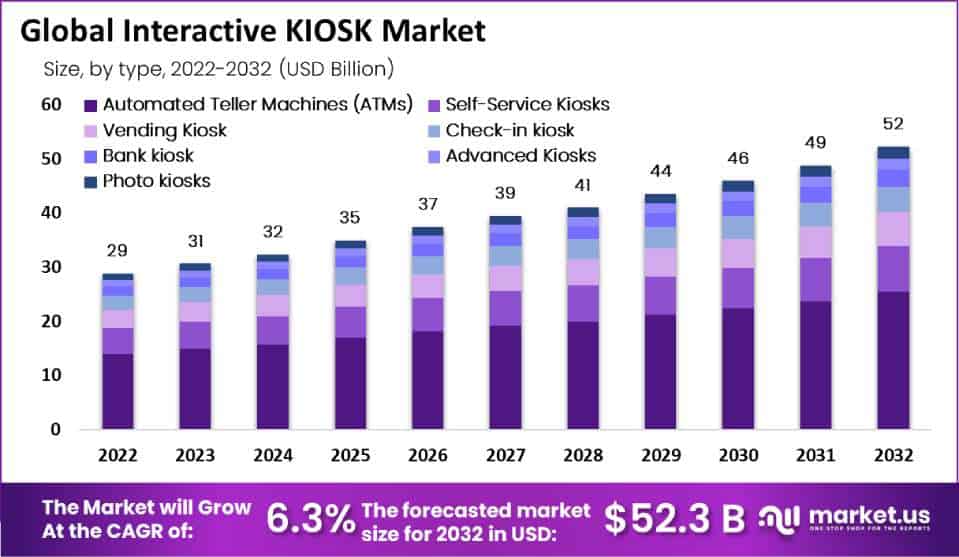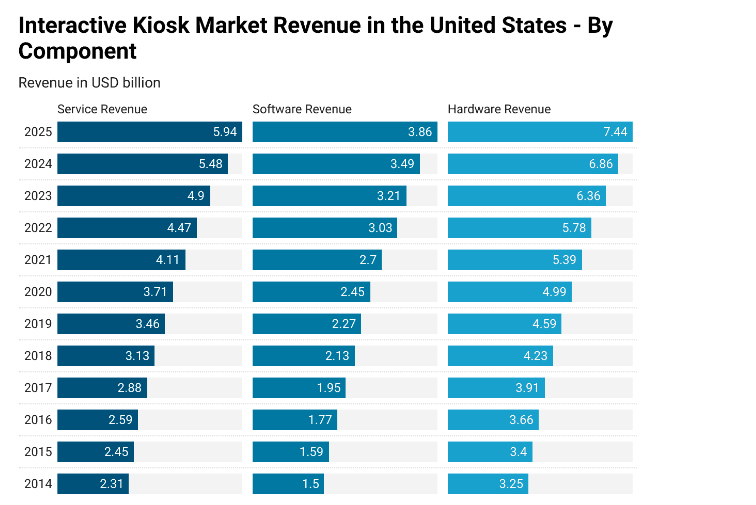Table of Contents
Introduction
The Global Interactive KIOSK Market is on track to grow significantly over the next decade. By the year 2032, the market size is projected to reach about USD 52 Billion. Starting from a valuation of USD 31 Billion in 2023, this growth trajectory represents a CAGR of 6.3% from 2023 to 2032.
This expansion reflects increasing demand across various sectors for interactive kiosks which provide users with self-service options. These kiosks are becoming more popular in settings such as retail stores, airports, and healthcare facilities, where they help streamline operations and improve customer experiences by reducing wait times and providing easy access to information and services.
An interactive kiosk is a self-service terminal featuring specialized hardware and software that provides access to information and applications for communication, commerce, entertainment, or education. These kiosks typically offer a user-friendly interface for easy interactions and are commonly used in various industries such as retail, healthcare, hospitality, and public sector to enhance customer service and streamline operations.
The interactive kiosk market is witnessing substantial growth due to the increasing demand for self-service in various service sectors. Businesses are adopting these kiosks to enhance customer service by offering users control over their transactions, thereby reducing wait times and improving operational efficiency. The market encompasses several types of kiosks, including self-service, informational, and ticketing kiosks, each catering to different user needs across diverse industries.

The major drivers for the interactive kiosk market include the rising demand for self-service terminals and automated systems in retail, healthcare, and banking sectors. Enhanced consumer experience, reduced operational costs, and the ability to provide round-the-clock service are significant factors propelling the adoption of kiosks. Additionally, the integration of advanced technologies like contactless payment systems, which increase transaction speed, also contributes to market growth.
Market demand for interactive kiosks is on the rise, particularly in sectors such as retail, transportation, and healthcare where efficiency and customer engagement are priorities. The adoption of kiosks in these areas is driven by their ability to streamline operations, offer convenient service, and manage high customer footfall effectively. With the ongoing digital transformation, more businesses are recognizing the benefits of deploying interactive kiosks as part of their customer service strategy.
There are significant opportunities in the interactive kiosk market with the expanding application in fast-growing sectors such as entertainment and public services. Innovations in touchscreen technology and connectivity offer potential for new kiosk functionalities that can attract a broader user base. Additionally, the growing trend towards digitalization in emerging markets presents a lucrative opportunity for the expansion of kiosk installations worldwide.
Take advantage of our unbeatable offer - buy now!

Technological advancements are continuously shaping the interactive kiosk market. Developments in AI and machine learning are making kiosks more interactive with capabilities such as voice recognition and personalized services. The integration of biometric technologies ensures secure access and use, broadening the scope of kiosk functions. Furthermore, IoT connectivity enables real-time data collection and analytics, enhancing service delivery and operational efficiency for businesses.
Interactive Kiosk Statistics
- The Interactive Kiosk Market is projected to grow from USD 31 Billion in 2023 to about USD 52 Billion by 2032. This growth indicates a steady CAGR of 6.3% from 2023 to 2032.
- Focusing on specific segments within this market, the Automated Teller Machine (ATM) sector notably dominated in 2022, securing over 48.6% of the market share. This significant portion underlines the crucial role ATMs play in the interactive kiosk landscape.
- Geographically, North America led the market in 2022, with revenues reaching USD 12.6 billion, accounting for more than 44% of the global market. This dominant share highlights the region’s robust adoption and integration of interactive kiosk technologies across various sectors.
- In terms of industry-specific dominance, the BFSI sector emerged as a key player, holding more than 49% of the market in 2022.

Source – market.us scoop
Emerging Trends
- AI Integration: Artificial intelligence is revolutionizing interactive kiosks, enhancing user experiences through personalized interactions and analytics. This technology is enabling more sophisticated services like predictive personalization, enhancing customer engagement across various sectors.
- Touchless Technology: Post-pandemic, there’s an increased emphasis on minimizing physical contact. Interactive kiosks are evolving to include touchless interfaces, voice command capabilities, and contactless payment options, catering to heightened hygiene and safety expectations.
- Adaptive Interfaces: Designing user-friendly and intuitive interfaces that cater to a diverse user base is a critical trend. These interfaces combine visual appeal with functionality, simplifying the user experience while accommodating different levels of tech proficiency.
- Expansion in Emerging Markets: There’s significant growth potential for interactive kiosks in emerging markets, driven by increasing digitalization initiatives across government, transportation, and retail sectors, which are investing in self-service technologies to enhance public and consumer services.
- Enhanced Service Efficiency: Interactive kiosks continue to be deployed widely in sectors like banking, healthcare, and retail to streamline operations and improve service efficiency. This not only helps reduce the workload on staff but also speeds up service delivery, making operations smoother and more efficient.
Top Use Cases
- Banking Services: Automated teller machines (ATMs) and other banking kiosks allow 24/7 access to a range of financial services like cash withdrawals, check deposits, and account management, reducing the need for in-person bank visits and enhancing customer convenience.
- Retail Applications: In retail environments, interactive kiosks provide services such as product information, inventory checks, and self-checkout processes, allowing customers to shop and check out without direct staff interaction, which streamlines the shopping experience and reduces wait times.
- Healthcare Check-ins: In the healthcare sector, patient information kiosks help streamline the check-in process, allowing patients to manage their appointments, fill out necessary forms, and access healthcare information without needing to interact with front desk staff.
- Food Service: Self-service kiosks in the food and beverage industry allow customers to place orders and make payments without interacting with staff, enhancing order accuracy and speeding up service delivery, particularly in fast-food restaurants.
- Information and Wayfinding: Kiosks equipped with maps and directories are invaluable in large spaces like shopping malls, airports, and universities, helping visitors navigate complex environments with ease and enhancing the overall visitor experience.
Major Challenges
- High Initial Investment: Setting up interactive kiosks involves substantial upfront costs, including the purchase of hardware, software, and integration systems, which can be a barrier for smaller businesses or those with tight budgets.
- Maintenance and Technical Glitches: Regular maintenance and the potential for technical malfunctions pose significant challenges. These issues can lead to downtime and disrupt service, affecting user satisfaction and operational efficiency.
- Regulatory and Compliance Hurdles: Interactive kiosks collect and manage user data, necessitating strict adherence to data protection regulations. Ensuring compliance with these laws can be complex and costly.
- User Interface Design: Designing intuitive and accessible interfaces is crucial. Poorly designed kiosks can lead to user frustration and reduced usage, which negatively impacts the return on investment.
- Resistance to Adoption: In some sectors, there’s hesitance towards transitioning from traditional to digital service methods. This resistance can slow down the integration of kiosks into everyday business operations.
Attractive Opportunities
- Enhanced Customer Experience: Interactive kiosks offer tailored customer services and enhance user engagement through personalized interactions, contributing to higher satisfaction and loyalty.
- Expansion in Retail and Healthcare: Kiosks provide significant opportunities in retail and healthcare by streamlining operations, such as checkouts in retail and patient check-ins in healthcare settings, which improve operational efficiency.
- Adoption of AI and Touchless Technologies: With advances in AI and touchless technologies, kiosks can deliver more personalized and hygienic user interactions, which are particularly valuable in the post-COVID-19 era.
- Growth in Transportation Sector: Interactive kiosks are increasingly being used in transportation for ticketing and providing travel information, which improves passenger experience and operational efficiencies.
- Geographical Expansion: The Asia Pacific region, with its large and growing population and rapid urbanization, presents extensive opportunities for the deployment of new kiosks across various industries, from entertainment to banking.
Conclusion
The interactive kiosk market is poised for robust growth, projected to expand significantly by 2033 due to the widespread adoption across various sectors and the integration of advanced technologies. Key drivers include the demand for enhanced customer service and operational efficiencies, supported by innovations in AI, IoT, and secure connectivity solutions. As businesses continue to embrace digital transformation, interactive kiosks serve as a critical tool in improving customer interactions and streamlining transactions in retail, BFSI, healthcare, and public sectors.
The ongoing technological advancements and strategic deployments in public spaces are set to further propel the market, providing both challenges and opportunities for industry stakeholders. The future of the interactive kiosk market looks promising, with a steady trajectory of growth driven by both technological progress and the evolving needs of a digitally-oriented consumer base.
Discuss your needs with our analyst
Please share your requirements with more details so our analyst can check if they can solve your problem(s)


